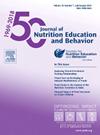Adolescent and Young Adult Social Media Food Marketing Exposure: Influence of Eating Behavior Traits on Brand Recall, Craving, and Purchase
IF 2.3
3区 医学
Q2 EDUCATION, SCIENTIFIC DISCIPLINES
引用次数: 0
Abstract
Background
The pervasive marketing of energy-dense food and beverages across many social media platforms continually targets and appeals to young consumers. This marketing also gets integrated into the entertainment content of these platforms through popular influencers, who leverage their social networks into revenue streams via collaborations with brands.
Objective
This cross-sectional study aimed to examine how exposure to food and beverage marketing messages within social media impacts adolescents’ and young adults’ brand recall and their behavioral responses, including craving and purchasing.
Study Design, Settings, Participants
Participants, Nf354, ranging in age from 13-24 years old, completed a series of online surveys on social media use, exposure to marketing within social media, and if they ever crave or purchase marketed products. Eating behavior questionnaires were administered, including the external food cue reactivity scale (EFRC), and the three-factor eating questionnaire (TFEQ-18).
Measurable Outcome/Analysis
Associations between hours spent on social media and eating behavior traits with marketing outcomes were both assessed using Poisson regression.
Results
Participants reported their primary social media platforms as YouTube (25%), Tik ToK (25%), or Instagram (22%). A majority of participants (67%) reported spending between 1-6 hours on social media daily. The self-reported number of hours spent on participants’ top social media platform significantly predicted the number of brands from a given list that the participants reported craving (β=1.14, p=0.01) and intending to purchase (β=1.18, p=0.007). Only higher EFCR scores were significantly related to greater brand recall (β=0.3, p≤ 0.001), craving (β=1.2, p≤ 0.0001), and purchase (β=0.83, p=0.001) of products seen on social media.
Conclusions
This study contributes to the growing body of evidence that high rates of exposure to digital food and beverage marketing on social media can impact adolescent and young adult behavior. Results provide implications for policy development that could aim to reduce the amount and power of exposure to marketing messages targeting young consumers. Future research is needed to explore potential intervention designs to combat the saturation of food marketing in digital media, especially for individuals hypersensitive to food cues.
Funding
None
青少年和年轻人的社交媒体食品营销曝光:饮食行为特征对品牌回忆、渴望和购买的影响
在许多社交媒体平台上,高能量食品和饮料的营销无处不在,不断瞄准和吸引年轻消费者。这种营销还通过受欢迎的网红整合到这些平台的娱乐内容中,这些网红通过与品牌合作,将他们的社交网络转化为收入流。本横断面研究旨在研究社交媒体上的食品和饮料营销信息如何影响青少年和年轻人的品牌回忆以及他们的行为反应,包括渴望和购买。研究设计,设置,参与者,Nf354,年龄在13-24岁之间,完成了一系列关于社交媒体使用,社交媒体营销曝光,以及他们是否渴望或购买市场营销产品的在线调查。进食行为问卷包括外部食物线索反应性量表(EFRC)和三因素进食问卷(TFEQ-18)。可测量的结果/分析花在社交媒体上的时间和饮食行为特征与营销结果之间的关系都是用泊松回归来评估的。结果参与者报告他们的主要社交媒体平台是YouTube (25%), Tik ToK(25%)或Instagram(22%)。大多数参与者(67%)表示每天花在社交媒体上的时间在1-6小时之间。自我报告的在顶级社交媒体平台上花费的时间显著预测了给定列表中参与者报告渴望(β=1.14, p=0.01)和打算购买的品牌数量(β=1.18, p=0.007)。只有较高的EFCR分数与更高的品牌召回(β=0.3, p≤0.001),渴望(β=1.2, p≤0.0001)和购买(β=0.83, p=0.001)显著相关。越来越多的证据表明,高曝光率的社交媒体上的数字食品和饮料营销会影响青少年和年轻人的行为。研究结果为政策制定提供了启示,旨在减少针对年轻消费者的营销信息的曝光量和力度。未来的研究需要探索潜在的干预设计,以对抗数字媒体中食品营销的饱和,特别是对于对食物线索过敏的个人。FundingNone
本文章由计算机程序翻译,如有差异,请以英文原文为准。
求助全文
约1分钟内获得全文
求助全文
来源期刊
CiteScore
4.20
自引率
11.50%
发文量
379
审稿时长
44 days
期刊介绍:
The Journal of Nutrition Education and Behavior (JNEB), the official journal of the Society for Nutrition Education and Behavior, is a refereed, scientific periodical that serves as a global resource for all professionals with an interest in nutrition education; nutrition and physical activity behavior theories and intervention outcomes; complementary and alternative medicine related to nutrition behaviors; food environment; food, nutrition, and physical activity communication strategies including technology; nutrition-related economics; food safety education; and scholarship of learning related to these areas.
The purpose of JNEB is to document and disseminate original research and emerging issues and practices relevant to these areas worldwide. The Journal of Nutrition Education and Behavior welcomes evidence-based manuscripts that provide new insights and useful findings related to nutrition education research, practice and policy. The content areas of JNEB reflect the diverse interests in nutrition and physical activity related to public health, nutritional sciences, education, behavioral economics, family and consumer sciences, and eHealth, including the interests of community-based nutrition-practitioners. As the Society''s official journal, JNEB also includes policy statements, issue perspectives, position papers, and member communications.

 求助内容:
求助内容: 应助结果提醒方式:
应助结果提醒方式:


